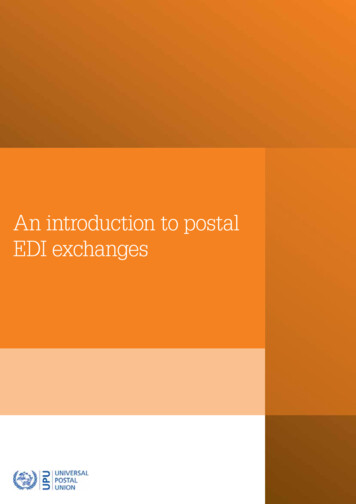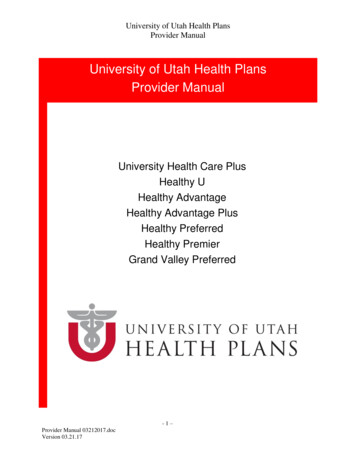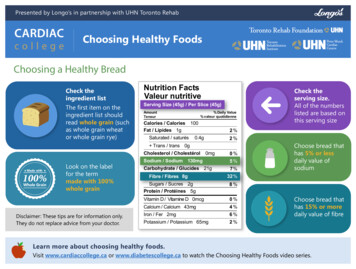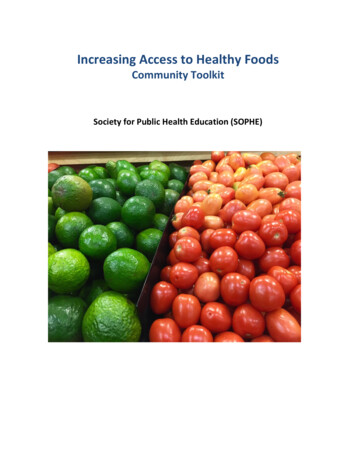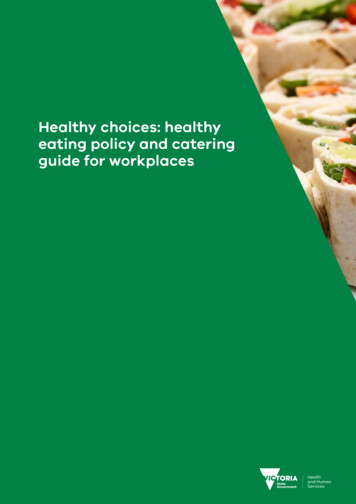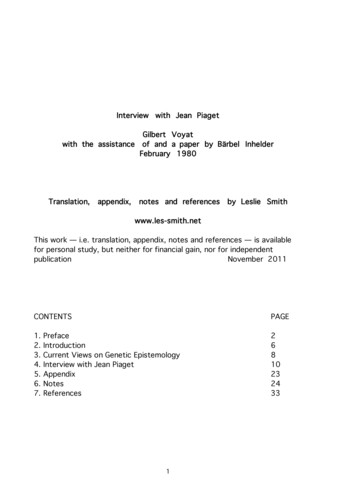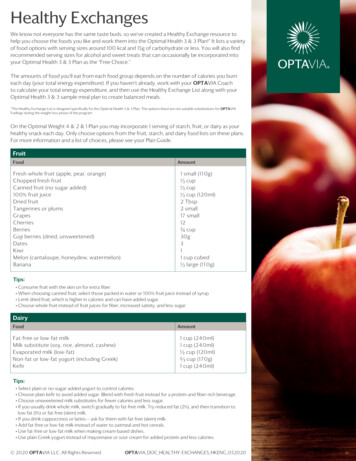
Transcription
Healthy ExchangesWe know not everyone has the same taste buds, so we’ve created a Healthy Exchange resource tohelp you choose the foods you like and work them into the Optimal Health 3 & 3 Plan!* It lists a varietyof food options with serving sizes around 100 kcal and 15g of carbohydrate or less. You will also findrecommended serving sizes for alcohol and sweet treats that can occasionally be incorporated intoyour Optimal Health 3 & 3 Plan as the “Free Choice.”The amounts of food you’ll eat from each food group depends on the number of calories you burneach day (your total energy expenditure). If you haven’t already, work with your OPTAVIA Coachto calculate your total energy expenditure, and then use the Healthy Exchange List along with yourOptimal Health 3 & 3 sample meal plan to create balanced meals.*The Healthy Exchange List is designed specifically for the Optimal Health 3 & 3 Plan. The options listed are not suitable substitutions for OPTAVIAFuelings during the weight-loss phase of the program.On the Optimal Weight 4 & 2 & 1 Plan you may incorporate 1 serving of starch, fruit, or dairy as yourhealthy snack each day. Only choose options from the fruit, starch, and dairy food lists on these plans.For more information and a list of choices, please see your Plan Guide.FruitFoodFresh whole fruit (apple, pear, orange)Chopped fresh fruitCanned fruit (no sugar added)100% fruit juiceDried fruitTangerines or plumsGrapesCherriesBerriesGoji berries (dried, unsweetened)DatesKiwiMelon (cantaloupe, honeydew, watermelon)BananaAmount1 small (110g)½ cup½ cup½ cup (120ml)2 Tbsp2 small17 small12¾ cup30g311 cup cubed½ large (110g)Tips: Consume fruit with the skin on for extra fiber. When choosing canned fruit, select those packed in water or 100% fruit juice instead of syrup. Limit dried fruit, which is higher in calories and can have added sugar. Choose whole fruit instead of fruit juices for fiber, increased satiety, and less sugar.DairyFoodFat- free or low- f at milkMilk substitute (soy, rice, almond, cashew)Evaporated milk (low-fat)Non-fat or low- f at yogurt (including Greek)KefirAmount1 cup (240ml)1 cup (240ml)½ cup (120ml)⅔ cup (170g)1 cup (240ml)Tips: Select plain or no-sugar-added yogurt to control calories. Choose plain kefir to avoid added sugar. Blend with fresh fruit instead for a protein-and fiber-rich beverage. Choose unsweetened milk substitutes for fewer calories and less sugar. If you usually drink whole milk, switch gradually to fat-free milk. Try reduced fat (2%), and then transition tolow-fat (1%) or fat-free (skim) milk. If you drink cappuccinos or lattes — ask for them with fat-free (skim) milk. Add fat-free or low-fat milk instead of water to oatmeal and hot cereals. Use fat-free or low-fat milk when making cream-based dishes. Use plain Greek yogurt instead of mayonnaise or sour cream for added protein and less calories. 2020 OPTAVIA LLC. All Rights Reserved.OPTAVIA DOC HEALTHY-EXCHANGES HKENG 052020
ProteinTypeAmountLean beef: trimmed of fat:ground round, roast (chuck, rib, rump), round, sirloin, steak(cubed, flank, porterhouse, T-bone), tenderloinBeef jerky*Beef: corned beef, ground beef, meatloaf, short ribs, tongueCheese with 3g of fat or fewer per 28gCheese with 4-7g of fat per 28gEggsLow-fat cottage cheeseEgg substituteEgg whitesFish, fresh or frozen: catfish, cod, flounder, haddock, halibut,orange roughy, salmon, tilapia, trout, tunaShellfish: clams, crab, imitation shellfish, lobster, scallops, shrimpFish, smoked: herring or salmon (lox)*Ostrich, venisonLamb: chop, leg, or roastOystersCanadian Bacon*Poultry, without skin: chicken, Cornish hen, domestic duck orgoose, turkeyLow-sodium deli meatsCanned tuna, salmon, or sardines in waterSausage with 3g of fat or fewer*Veal: loin, chop, roastMeatless burgerTofuTempehSeitanHummus60g30g30g60g30g1½ cup½ cup460g60g30g60g60g12 medium60g60g60g30g60g30g1 patty120g¼ cup60g¼ cup*High in SodiumTips: Choose the leanest cuts of beef, such as round steaks and roasts (eye of round, top round, bottom round,round tip), top loin, top sirloin, and chuck shoulder and arm roasts. Select the leanest pork choices, such as pork loin, tenderloin, center loin, and ham. Buy skinless poultry, or remove the skin before cooking. Choose skinless chicken breast for the leanestoptions. Choose low-sodium lean turkey, roast beef, or ham for sandwiches instead of processed deli meats such asbologna or salami. Trim away all of the visible fat from meats and poultry before cooking. Skip breading on meat, poultry, or fish. Include fatty fish (salmon, mackerel, herring, lake trout, sardines and albacore tuna) at least two times a weekfor heart-healthy omega-3 fatty acids. 2020 OPTAVIA LLC. All Rights Reserved.OPTAVIA DOC HEALTHY-EXCHANGES HKENG 052020
StarchFoodAmountBreadPita, 6 inches (15cm) in diameterTortilla, 6 inches (15cm) in diameterNaan, 8 inches (20cm) by 2 inches (5cm)Roti/chapattiEnglish muffin, hamburger or hot dog bunMini bagelHot cereal, cooked (oatmeal, cream of wheat)Oat branWheat germReady-to-eat, unsweetened cerealSweetened cerealGranola or muesli (low-fat or regular)Bulgur, wheat branCooked barley, couscous, millet, pasta, polenta, quinoa, white orbrown riceSoba noodlesStarchy vegetables (corn, peas, potatoes, sweet potatoes)Winter squash (acorn, butternut, pumpkin)Beans and lentils (mung beans, pinto beans, black beans)Adzuki beansBaked potato (all varieties)Pretzels (original, baked)Air-popped popcorn (low-fat or no sugar added)Crackers (original or whole wheat)Rice cakesBaked chips (original) (potato, tortilla, pita)1 slice½1¼1 small, 6 inches½1½ cup¼ cup3 Tbsp¾ cup½ cup¼ cup½ cup⅓ cup30g½ cup1 cup½ cup, cooked⅓ cup, cooked½ medium (90g)20g3 cups6215 (20g)Tips: Substitute a whole-grain product for a refined product such as whole-wheat bread instead of white, brownrice instead of white, whole wheat pasta instead of white, etc. Try sweet potatoes with the skin on instead of white potatoes for more nutrients. They can be cooked in themicrowave in minutes. Choose beans and lentils for extra protein and fiber. Soak dried ones overnight to reduce cooking time.If you’re choosing canned, be sure to rinse through a colander to remove excess sodium. Experiment by substituting whole-wheat or oat flour for up to half of the flour in pancakes, waffles, muffins,or other flour-based recipes. Use whole-grain bread or cracker crumbs instead of white bread crumbs. Try rolled oats or a crushed, unsweetened, whole-grain cereal as breading for baked chicken, fish, veal, oreggplant parmesan. Try an unsweetened, whole-grain, ready-to-eat cereal as croutons in salad or in place of crackers with soup. Foods labeled with the words "multi-grain," "stone-ground," "100% wheat," "cracked wheat," "seven-grain," or"bran" are not always whole-grain products. Color is not an indication of a whole grain. Bread can be brown because of molasses or other addedingredients. Read the ingredient list to see if it is a whole grain. Use the Nutrition Facts label, and choose whole-grain products with a higher fiber content. Many,but not all, whole-grain products are good or excellent sources of fiber. Read the food label’s ingredient list. Look for products without added sugars (such as sucrose, high-fructosecorn syrup, honey, malt syrup, maple syrup, molasses, or raw sugar) that add extra calories. Look for 100-calorie sandwich rolls, often labeled “light” or “thins.” 2020 OPTAVIA LLC. All Rights Reserved.OPTAVIA DOC HEALTHY-EXCHANGES HKENG 052020
FatsFoodOil, any typeNut butterAlmondsCashewsPeanutsPistachiosSalad dressingButterAvocadoOlivesTahiniSeeds (sesame, sunflower, flax)Chia seedsBaconLight coconut milkCream cheeseGuacamolePestoGheeAmount2 tsp1 Tbsp121220321- 2 Tbsp2 tsp4 Tbsp (60g)16- 2 0 large1 Tbsp2 Tbsp1 Tbsp2 slices, cooked½ cup2 Tbsp¼ cup1 ½ Tbsp2 tspTips: Use small amounts of fats, which provide essential nutrients. Choose oils over solid fats. All fats and oils are a mixture of saturated fatty acids and unsaturated fatty acids.Solid fats contain more saturated fats and/or trans fats than oils. Saturated fats, trans fats, and cholesteroltend to raise LDL (bad) cholesterol levels in the blood, which increases the risk for heart disease. Select mostly polyunsaturated (PUFA) or monounsaturated (MUFA) fats. Oils are the major source of MUFAsand PUFAs in the diet. PUFAs contain essential fatty acids, so named because they are necessary for health. Include nuts, seeds, nut butters, tahini, olives and avocados, which provide protein and/or fiber, so they maybemore satiating. 2020 OPTAVIA LLC. All Rights Reserved.OPTAVIA DOC HEALTHY-EXCHANGES HKENG 052020
Non-starchy VegetablesIn addition to your Healthy Exchange options, you can add the following Free Foods to your meals :FoodAmountArtichoke hearts, asparagus, baby corn, green beans,yard long bean, beets, Brussels sprouts, green cabbage,white cabbage, Bok Choy, Chinese flat cabbage, cauliflower,broccoli, celery, chayote, cucumber, daikon, eggplant,leafy greens (Collard, kale, mustard, turnip), jicama (yam bean),kohlrabi, leeks, mixed vegetables (without corn or peas),mung bean sprouts, soybean sprout, mushrooms (all kinds),okra, onions, peppers (all varieties), radishes, salad greens(chicory, endive, escarole, lettuce, romaine, arugula, radicchio,watercress, etc.), sauerkraut*, spinach, squash (summer,crookneck, zucchini), sugar snap peas, Swiss chard, tomatoes,tomato/vegetable juice*, turnips, water chestnuts½ cup cookedvegetablesor vegetable juice1 cup raw vegetables*May be high in sodiumTips: If you eat three cups or more of raw vegetables or 1 ½ cups of cooked non-starchy vegetablesin a meal, count them as one Healthy Exchange option. Canned vegetables may have added salt. Look for low-sodium or no-salt-added varieties whenpossible. Drain and rinse canned vegetables to remove excess salt. Starchy vegetables such as corn, peas, potatoes, and winter squash have more calories andcarbohydrates, so they are listed on the Starch List. Keep washed, cut raw vegetables such as carrots, cucumber, broccoli, radishes, celery, bellpeppers, and cherry tomatoes on hand regularly. Add chopped or pureed vegetables to sauces, soups, stews, and casseroles. Incorporate raw or lightly cooked vegetables, such as spinach, tomatoes, and onions, intosandwiches, omelets, stir fries, and pasta or rice dishes. Aim to fill half of your plate with non-starchy vegetables at meals. They are low in calories andprovide a great source of fiber, vitamins, and minerals. 2020 OPTAVIA LLC. All Rights Reserved.OPTAVIA DOC HEALTHY-EXCHANGES HKENG 052020
Free Choice items onlyAlcoholBeverageAmountBeerLight beerDistilled spirits: vodka, rum, gin, whisky (40% vol or 43% vol)SakeWine: dry, red or whiteWine: dessert (sherry)240ml350ml45ml60ml150ml110mlTips: If you choose to drink alcohol, keep in mind that it contributes extra, unnecessary calories, may stimulate theappetite, and may lead to dehydration. Alcohol does not offer any nutritional value. Choose a distilled spirit and zero- calorie chaser (for example, rum and Diet Coke , vodka and Diet Sprite orgin and diet tonic, etc.) which will not add carbohydrates. Avoid mixed drinks such as margaritas, daiquiris, etc. which are high in calories and sugar. Drink a glass of water in between every alcoholic beverage. Always drink alcohol with food and do not skip meals to make up for liquid calories.Sweets and DessertsFoodChocolate “Hershey Kisses”MuffinLow- fat ice creamFrosted cakeChocolate chip cookieFat- free puddingAngel food cakeBrownieGingersnap cookieVanilla waferMini ice cream sandwichFun- s ize candy barFruit snacksFruit leatherDark chocolate (at least 70% dark)Unsweetened cacao nibsAmount4 pieces¼ (30g)½ cup3cm square1 (6cm across)120g½12 of cake (about 60g)3cm square (about 30g)3 cookies4 cookies1130g2 strips1 square (14g)30gTips: Limit the consumption of sweets and desserts, as they provide calories without offering nutritional value. Indulge in sweets and desserts after consuming a balanced meal to help keep blood sugar stable. Keep in mind that sweets and desserts may increase cravings and lead to overeating.OPTAVIA FuelingsFoodOPTAVIA Fuelings 2020 OPTAVIA LLC. All Rights Reserved.Amount1OPTAVIA DOC HEALTHY-EXCHANGES HKENG 052020
Foods labeled with the words "multi-grain," "stone-ground," "100% wheat," "cracked wheat," "seven-grain," or "bran" are not always whole-grain products. Color is not an indication of a whole grain. Bread can be brown because of molasses or other added ingredients
